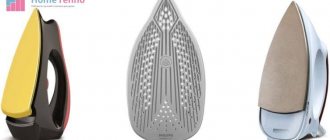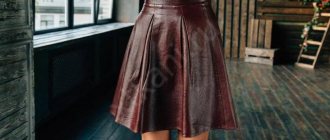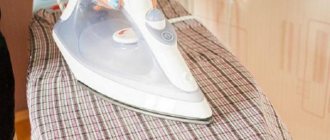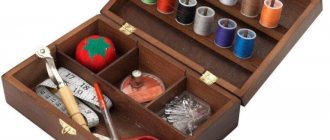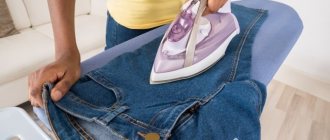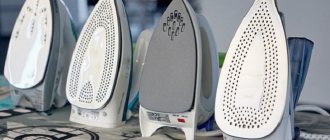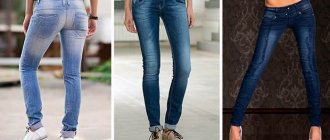When updating our wardrobe for summer, we all mostly give preference to natural fabrics. They have a number of undoubted advantages over synthetic ones: they perfectly absorb moisture and allow air to pass through, which gives a comfortable feeling while wearing. However, they also have one drawback, which sometimes brings a lot of inconvenience - great creasing. You can iron your dress perfectly in the morning, sit down on public transport and... it will lose its neat appearance. The thing is that threads made of linen, cotton and wool have a loose structure: their cavities are filled with air (due to which the skin “breathes” in them) and are easily deformed under load - the surface of the fabric loses its smoothness and evenness. What should you do to ensure that the item does not wrinkle and remains presentable throughout the day?
Rating of wrinkle-resistant fabrics
Before purchasing any item, check whether it is wrinkled. To do this, just squeeze the material tightly in your hand and hold it for 10 seconds. As a result, you will see which tissues are restored and which ones remain damaged. Note that linen, cotton and natural silk wrinkle the most. Viscose fabric - a staple - noticeably wrinkles (in order not to struggle with wrinkles, you can choose a variegated color of the fabric). Satin and chiffon may wrinkle, but to a lesser extent. But fabrics based on polyester or with a small addition of it are completely wrinkle-resistant.
In order to reduce the wrinkleability of fabric, you can use grandma’s method: starch the item. The recipe is quite simple: dilute a tablespoon of starch in a liter of cold water, soak the item in the solution, dry it, and then iron it with a hot iron. The essence of the method is that starch emulsion under the influence of high temperature leaves a hard but breathable film on the fabric. This film protects the structure of the material from severe creasing and rapid contamination. Additional bonuses: the item looks much more beautiful and is easier to iron. However, hand washing clothes is not suitable for everyone. If you don’t want to fuss for a long time, you can use store-bought starching products. They can also help solve this problem. Some of them are added to the powder during washing, while others are in the form of a spray and sprayed onto dry fabric before ironing. If clothes wrinkle, it’s not always a hopeless situation. With the help of these tips, you can reduce fabric wrinkles and help your items maintain a neat appearance.
The modern world offers a lot of opportunities - entertainment, family, career, travel. In a short period of time, equal to twenty-four hours, you want to fit everything in the world and a little more. Household appliances have reduced manual labor to nothing: even in order to wash clothes, you just need to load things into the machine and press a button.
Fabric that needs to be ironed is now called capricious and demanding. Nobody wants to waste their time on a routine that can be avoided. That is why wrinkle-resistant fabrics that do not require additional care are so popular.
Natural fabrics
After being crushed, the terry threads elastically return to their places.
Natural materials are safe, environmentally friendly and feel pleasant to the body. However, it is natural fabrics, unlike synthetics, that wear out quickly. Natural, linen and wool cannot be classified as wrinkle-resistant materials. However, thanks to manufacturing technology or special weaving, some types of textiles are very easy to care for and keep their shape well
and practically do not wrinkle.
Denim
Denim is the material from which the famous blue trousers are made. All varieties contain natural cotton. When making fabric, the fibers are well twisted on special ring-spinning machines, and the threads are connected with a very strong twill weave. The material is easy to recognize by its painted front side and pale back.
They sew from denim:
- trousers, shorts, overalls;
- jackets, jackets and vests;
- skirts and dresses.
Denim is a very dense, wear-resistant fabric that is breathable and absorbs moisture well. The material with the addition is called stretch and not only does not wrinkle, but stretches elastically and fits tightly to the figure.
Cotton terry (frote)
Terry fabric looks very interesting - its entire surface is covered with soft pile, which consists of elongated loops and looks like fur. The pile can be one-sided, two-sided, and also varies in thickness and length. There are varieties with a relief pattern, reminiscent of a print, as well as cut terry. The fabric is made from natural cotton, as well as from bamboo and.
What is sewn from terry:
- towels and bedspreads;
- robes;
- mattresses and pillows.
Terry is knitwear, that is, knitted fabric consisting of loops. After being crushed, the threads elastically return to their places; simply straighten and smooth the material. The lint is good for health because it easily massages the skin.
How does cotton differ from other materials?
The textile industry market is replete with a variety of materials. You can determine which material is better by studying the properties of each and comparing them with the characteristics of cotton fabrics.
How to distinguish cotton from synthetics
There are different types of synthetics, however, the properties of each type of synthetic materials are relatively the same. Synthetics, unlike cotton, do not wrinkle, do not allow moisture to pass through easily, and generate static electricity. If you can't figure out whether it's cotton or synthetic, look at the labeling. The presence of spandex, elastane or substances with the prefix “poly” indicates that it is synthetic. In addition, cotton materials can withstand high temperatures well, while synthetics can easily stick to the sole of the iron. If you burn a small piece of fabric, the synthetics will simply melt, and the cotton will burn and produce smoke with the smell of burnt paper.
The difference between the material and satin
Sateen is cotton, but only made by a special method of weaving the best and longest cotton fibers. Unlike natural cotton, satin has a characteristic shine on the surface. There are often cases when synthetic fibers are added to satin to increase the wear resistance and service life of the material.
The difference between cotton and calico
Calico is a type of cotton produced by plain weaving. The result is a fairly dense canvas with a matte surface. Calico is considered a lower quality material than cotton, withstands fewer washes, shrinks more often and quickly loses its color saturation.
The difference between cotton and cotton
Cotton is not a specific type of fabric, but just a name for cotton in English.
How to understand where is cotton and where is linen
Unlike cotton, linen is stiffer, stronger and attracts less dust. Linen items are warmer than cotton items. In appearance, linen has a little more shine than cotton. The material also wrinkles more and is difficult to smooth out. To learn how to determine in the future whether you are looking at cotton or linen, visit a fabric store and study both materials based on their external properties.
How is cotton different from poplin?
Both materials are made from natural cotton fibers, but differ greatly in appearance due to special processing and weaving of the threads. Poplin, unlike classic cotton, is more durable and reliable, but costs more.
The difference between fabric and viscose
Viscose is an artificial material made from wood cellulose. The fabric can consist of either 100% pure raw materials or contain additional artificial or natural fibers. In its pure form, viscose is used extremely rarely, as it suffers greatly from water and is not very durable. Most often, elastane, polyester or pure cotton fibers are added to the material. Viscose, unlike cotton, does not shrink, fades less in the sun, and holds its shape worse.
How to distinguish cotton from polycotton
Polycotton is a mixture of natural cotton fibers and polyester threads. Unlike cotton, polycotton is less pleasant to the body, less breathable and can cause skin reactions. However, products made from polycotton last longer, are more wear-resistant, practically do not wrinkle and are cheaper.
Blended fabrics
With the invention of synthetic fibers, which are produced chemically, appeared. The material is a combination of natural and synthetic threads, which allows you to create textiles that have the advantages of both groups. Mixed fabrics are universal, suitable for creating clothing and various special uniforms
, . The combination of dissimilar fibers allows you to create durable, wear-resistant and practical fabric.
Most often, cotton is used as a base - natural fibers of plant origin. There is usually less cotton in the composition, up to 40%. A prominent representative of wrinkle-resistant mixed fabrics is used to create bed linen (more about this fabric will be discussed below).
It is thanks to the synthetic component that mixed textiles practically do not wrinkle, hold their shape well, do not deform, do not shrink, and in most cases are very elastic.
There are also completely synthetic materials consisting of several types of chemical fibers (for example,).
What composition should a shirt have to prevent wrinkles?
What should be the composition so that they do not wrinkle? High-quality branded products are made from 100% cotton with a special weave of threads. In cheaper shirts, a combination of natural and synthetic fibers is acceptable. The optimal proportion is: 65% cotton + 35% polyester.
Interesting materials:
What is the best bathroom sealant to use? What is the best navigator for Android? Which is the best launcher for Android? What is the best wallpaper color for the kitchen? What is the best navigator for Ukraine? What is the best washing powder for an automatic machine? What's the best color for a bedroom? What material is best for a sink? What material is best to use to insulate a bath? Which mattress is best for a wardrobe bed?
Wrinkle-resistant fabrics for bed linen
Due to the elasticity of the fibers, satin bed linen practically does not wrinkle.
Sleeping sets are used very often, every day. Lingerie should not only be beautiful and pleasant to the touch, but also very practical in order to save time on caring for it. The most popular are smooth, wear-resistant fabrics that do not shrink, fray or fade. Of course, wrinkle-resistant materials should be given preference first of all, because ironing double sheets and duvet covers is a challenge and a pleasure.
Percale
This material can be classified as natural fabrics. made from untwisted cotton threads of increased strength. This material was used to make sails and skins for the first types of aircraft. Percale is a smooth, wear-resistant, hygroscopic and shape-resistant fabric. The dense texture protects the textile from creasing.
In addition to bed linen, the following are made from percale:
- dresses, shirts and ;
- children's walking envelopes;
- tents, parachutes and sails.
The fabric is very easy to care for, does not require special operating conditions, does not become electrified during use and retains color perfectly.
Polycotton
Polycotton is a blended fabric consisting of polyester and cotton, hence the name (poly + cotton). The composition of the material varies, differing in the percentage of cotton and synthetics. The most affordable fabrics contain less natural fibers.
The following are made from polycotton:
- bedding sets (pillowcases, duvet covers, sheets, bedspreads);
- covers for blankets and pillows.
Polycotton is a very durable and strong material, it practically does not wrinkle and does not require additional care. The fabric does not stretch or shrink, all stains are easily washed off, and the products, no matter how voluminous they are, dry quickly.
Poplin
The material is a soft double-sided fabric with a fine ribbed texture. Poplin was originally made from pure silk, but now cotton and synthetic options are popular, as well as a combination of warp and wool weft. The material comes with patterns, single-color, and also multi-colored.
In addition to bed linen, poplin is used to make:
- blouses, shirts, dresses;
- T-shirts and tank tops;
- , home clothes.
The fabric does not cause allergies, retains heat and absorbs moisture, retains its shape and color perfectly, and is inexpensive. Poplin practically does not wrinkle and does not require care.
Satin
An excellent option for delicate, soft bed linen. – a delicate, glossy fabric with a smooth horizontal pattern of weaving threads (the weaving method is called satin). Traditionally the fabric is made from silk, but economical cotton variations are available.
They also sew from satin:
- dresses, blouses, skirts, sundresses;
- Men's shirts.
Despite its thinness and apparent decorativeness, satin is a very durable material, it practically does not wrinkle due to the elasticity of the fibers and can withstand more than 300 washes before it begins to fade slightly.
Synthetic fabrics
Nylon looks attractive and is affordable.
Often, when they see a 100% synthetic composition on the label of an item, buyers frown with a sigh: “Synthetics! Chemistry!". However, the only fault of synthetic materials is that they were created by man using science and modern technology, and not processed from organic materials like cotton or wool.
With proper quality of products, synthetics are absolutely safe, and their properties are not only not inferior to natural fabrics, but also often surpass them in terms of wear resistance and strength.
Lycra
It is an elastic, stretchy material. Sometimes, meaning lycra, such fabrics are called elastane. These are not synonyms, but also not different fabrics - simply a synthetic elastic type of textile that is made by different companies and gives them their own names.
Lycra stretches and does not tear due to its special texture - synthetic fibers resemble segments connected to each other by thin “bridges”.
They sew from lycra:
- turtlenecks, dresses, leggings;
- sportswear;
- underwear;
- socks and stockings.
In addition to the fact that lycra does not wrinkle and stretches well, the fabric is moisture resistant, durable, light and pleasant to the touch.
Nylon
As a result of research by the chemical company DuPont, a durable chemical material was invented, which was called nylon. The fabric consists of polyamides, which after a chemical reaction are transformed into thin fibers.
A huge number of things are made from nylon:
- underwear;
- hosiery;
- casual clothes (T-shirts, pants, sweaters, dresses);
- tourist, sportswear;
- uniforms.
In addition to the fact that the fabric does not require ironing, it is very wear-resistant, light and durable. Nylon protects from cold and wind, looks attractive and is affordable.
Polyester
A synthetic material that resembles natural wool in appearance, but has the same characteristics and properties as cotton. Fibers are obtained as a result of oil refining.
The material used is:
- underwear;
- dresses, sweaters, skirts, suits;
- outerwear.
Polyester is very durable, retains its shape, practically does not wrinkle, is very easy to wash and does not require any special care or ironing.
Taffeta
Blended synthetic fabric, consisting of nylon and polyester. Taffeta is a lightweight, practical, thin fabric with a glossy surface; it is a synthetic analogue of silk or cotton taffeta.
Taffeta is used to make:
- flags, interior decor;
- raincoats and down jackets;
- tracksuits;
- special and tourist clothing.
Taffeta is quite rigid and shape-resistant, and therefore does not wrinkle.
Microfiber (microfiber)
The main feature of the material is the finest fibers with a diameter of about 0.06 mm. Microfiber is also called dissected - it is treated with a special compound that divides the material into equal segments and actually cuts it.
Here's how microfiber differs from regular thread
This material is used to make:
- bed linen and ;
- children's clothing;
- everyday and household items;
- elements of outerwear.
Microfiber perfectly absorbs moisture, it is very light, does not shrink, does not wrinkle, and dries instantly after washing.
Meryl
It is a brand name, a type of microfiber. The fabric is smooth, can be shiny or matte, and is made from nylon. The following is made from the measure:
- sportswear;
- T-shirts and other types of clothing that are worn directly on the naked body.
Meryl is a flowing silky fabric, it does not accumulate static electricity, does not pill, covers the body like a second skin, and also does not wrinkle due to its elasticity.
Tactel
Another type of microfiber, also a trademark. The material is made of polyamide. Tactel is produced in several varieties - ultra-thin fabric, soft, shiny, melange. From taktel they sew:
- underwear and bed linen;
- elements of sportswear;
- things adjacent to the body (T-shirts, T-shirts).
The material is very durable, aesthetic and durable. The main feature is incredible softness, although the fabric may look dense and rough, as well as resistance to wrinkles and folds.
Reaper
Among the list of wrinkle-resistant fabrics, one cannot fail to mention a material that is also not afraid of folds, because the fabric is already a crumpled fabric. We are talking about a reaper. This is an original fabric that retains its interesting appearance after washing, drying, and when stored flat for a long time. The header is not ironed.
The material is made from a variety of fibers:
- wool;
- silk;
- cotton;
- synthetics.
In fact, a reaper is a type of textile decoration. To achieve a crumpled effect, the finished fabric is folded and twisted, and then the material is heat treated and pressed. The result is persistent creases and wrinkles that do not smooth out under the weight of the fabric. Most often, tightly twisted fibers are used to create the material.
The following types of headers are distinguished:
- natural fabric;
- artificial (viscose);
- synthetic;
- mixed.
Dresses, shirts, blouses, skirts, and bed linen are sewn from the reaper. The material is not capricious, it does not need to be ironed, but is washed according to the information on the label, because the composition of the fabric varies and each specific product requires an individual approach.
conclusions
There are a huge number of wrinkle-resistant fabrics. There are natural, synthetic, blended options, as well as a unique variety of reaper fabric, which made the list due to the fact that it does not need to be ironed.
Wrinkle-resistant fabrics are very practical, and at the same time they have a lot of other positive properties - from hygroscopicity to color fastness, and also have a wide range of applications. Materials that are resistant to deformation are used for sewing bed linen, casual clothing and specialized suits.
Linen products have always been famous for their high quality and positive properties. Linen fabric has been used for a long time in the manufacture of various items of clothing, tablecloths, towels, bed linen, napkins, and decorative interior elements.
Due to the structure of natural fibers, linen items have high air conductivity, which promotes optimal heat exchange and cooling of the human body in conditions of high ambient temperatures. In addition, linen fabric absorbs moisture well and at the same time promotes its rapid evaporation, which is especially important when sweating heavily. According to these indicators, linen is superior to other types of natural fabrics, such as silk or cotton. In addition, linen items are durable, pleasant to the touch, retain their appearance for many years, are easy to wash and dry quickly.
Linen fabric is quite difficult to iron - it wrinkles very quickly
The few disadvantages of linen fabric include the fact that it wrinkles quickly, as well as a certain difficulty in ironing such material. To avoid damaging the fabric and leaving iron marks on things, you need to remember a few simple rules and useful tips on how to iron linen.
Things that look harmonious with folds
There are a number of fabrics and things that, having a wrinkled appearance, do not look sloppy, but on the contrary, will highlight your style. But remember: this method is not suitable for all materials and cannot be used in every situation.
The following things can be done without ironing:
- jeans. They have a structure that, after half an hour of wear, will eliminate the wrinkles on its own, but if not, others may think that this was intended;
- sweatshirts, hoodies, cotton T-shirts. Small errors are allowed on these items, provided that these are not marks from clothespins or a “scar” left from drying on a clothesline, unsightly cutting the entire product in half;
- thin cotton jackets. In combination with the right addition, they will allow you to look stunning among “ironed collars” even in an imperfectly ironed form;
- linen outfits. The naturalness of the material, in addition to light, careless bruises, even looks advantageous, adding charm and texture to things;
- work clothes. Shirts made from thin denim do not like a shiny shine, and a slight wrinkle does not spoil their appearance at all.
Whatever one may say, not ironing clothes is not an option. Often, unpleasant and deeply structured creases are discovered at the most inopportune time, when there is absolutely no way to thoroughly deal with them. And what to do if a very wrinkled fabric does not allow the ironing process? You may not know, but an iron is not the only assistant that can smooth out wrinkled fabric.
Choosing the right iron
It is quite difficult to straighten out the folds of a crumpled linen item, and improper ironing can cause damage to the fibers of the fabric. You can avoid this, and also make the process of ironing linen easier, by using a properly selected iron. To do this, when choosing it, you should pay attention to the following parameters:
Iron weight
A heavy iron will greatly simplify the process of ironing linen.
When ironing linen fabric, it is better to use a heavy iron. With its help, even a heavily wrinkled item can be ironed quickly and without much effort.
Handle shape
Such an element of the iron should be comfortable, suitable in size and shape to the hand of its owner.
Availability and type of steaming system
Linen items are much easier to iron with an iron with a steam system. At the same time, the design of the iron, in which the holes are located over the entire surface of the sole, is more effective than with holes in only one part of it.
Sole type
An iron with a ceramic soleplate is best suited for linen items.
The best option for the type of iron sole is a ceramic base with a special non-stick coating. Metal iron soles are at risk of corrosion, scratches, and chips. The use of such devices can cause rust stains that are difficult to remove.
Preparing for ironing
Linen items cannot be ironed without moisture
Before you learn how to iron linen so that it doesn’t wrinkle, you should talk about preparing everything you need. We will need an iron, an ironing board or a prepared surface of sufficient area, a spray bottle for moisturizing and a clean, thick lining. Before ironing linen items, you need to perform a number of preparatory steps:
- Completely remove dirt stains from linen fabric. After heat treatment with an iron, it will be much more difficult to remove such marks.
- Install the ironing board or choose an ironing surface at such a height that it is as comfortable as possible to work with the iron, without unnecessary strain on the back muscles and wrists.
- Place a clean pad made of thick material on the ironing board or prepared surface.
- Linen fabric should be slightly moistened. Ironing dry linen fabric is much more difficult.
To keep things fresh and pleasant smelling for a long time, before ironing, you can treat the product with a special conditioner for linen fabrics.
How to prepare an ironing area
Virtuosos can get the perfect result on a table covered with a blanket, but it is better to have an ironing board. For right-handers, it should be installed with the rounded end to the left, for left-handers, accordingly, to the right. The light should fall on the workplace from the side of the less active hand, the cord should freely follow the iron and not interfere with the ironer.
It’s good to have gauze or a special ironing cloth and a container of water on hand. As a rule, modern irons are equipped with sprinklers, but a spray bottle will help moisten the item much faster.
How to iron linen correctly
To find out at what temperature to iron linen, you must first carefully study the manufacturer’s recommendations indicated in the annotation and on the product label. Such information is usually presented in the form of standard symbols and signs; it will tell you how to iron linen items:
- One point - the product is intended for wet heat treatment at the lowest possible iron temperature.
- Two dots - this means that the item is made of natural fabric with the addition of fibers from synthetic materials. This product is ironed easier and faster. In this case, you can use medium and high iron temperatures without the risk of damaging the fabric.
- The crossed out iron on the label means that ironing is not recommended for this linen product.
All this information will help you determine how to iron linen items correctly and choose the appropriate temperature setting. Having prepared everything you need, you can begin directly ironing the linen.
Even heavily wrinkled items can be ironed without an iron: by wetting them and letting them hang thoroughly
As already mentioned, linen fabric is not easy to iron. Therefore, it is better to iron linen items immediately after washing. At the same time, during the ironing process, they must be constantly moistened with a spray bottle, and also use cushioning damp gauze or thin cloth. Gauze should also be used if the linen product has various decorative elements, for example. Such areas are ironed from the wrong side through interlining fabric. When ironing starched linen items, reduce the iron temperature and use a medium or low temperature setting.
It should be remembered that the specific structure of linen fabric is such that it is almost impossible to completely smooth out all the folds and make it absolutely even. However, this is not required, since flax is initially inherent in some carelessness. This is a characteristic feature of this material and gives it a peculiar charm and originality. However, regular ironing of linen items in compliance with certain rules is still necessary. It will extend their service life and attractive appearance.
Reading time: 5 minutes
Linen is an environmentally friendly natural material, very popular due to its excellent hygienic and temperature-regulating properties. This is one of the fabrics that not only do not lose their quality over time, but also improve. The more you wash linen clothes, the softer and more comfortable they become. But when washing such clothes, you must adhere to a number of simple rules. Let's see how to care for a linen dress, how to iron it, what to do if a linen dress is itchy or wrinkled a lot.
- Sort items by color: colored items should not be washed with white or light-colored items.
- Carefully read the composition of the material on the label. It also contains care instructions. Do not wash linen clothes together with items made from other fabrics.
- Gentle hand washing is recommended, but linen can also be washed in an automatic machine on one of the gentle cycles.
- Since linen absorbs water well, do not load the washing machine too much; if there are too many clothes and they absorb most of the water, the clothes will not wash well.
- You need to rinse linen clothes very carefully, since detergent particles remaining in the fibers can damage the structure of the fabric.
- If you need to use chemicals to remove heavy stains, check their effect on an inconspicuous area of the product - collar, inner seam, pocket. If the structure of the fabric is not disturbed and it does not “shed”, the entire product can be processed.
- Linen should also be dried and ironed according to the rules.
How to iron a leather dress
But with leather, everything is a little different: this material is natural, and it “breathes,” which means you can try a few tricks with it to smooth out wrinkles without the help of an iron.
- The creases may go away on their own if you just let the dress hang out for a few days.
- If you don't have much time, try ironing the dress by hanging it in the bathroom after you take a hot shower. This steam is cooler and more harmless to the skin than that created by a steamer, and it straightens out creases no worse. In general, when wet, the skin straightens out, but it is important to wet it just a little, since excess moisture can lead to deformation.
- If the creases are strong, then you will have to either stroke the skin from the inside through gauze, or still steam it with a steam generator, holding it at a distance of 10-15 cm from the product.
- For very strong creases, you can also use a press: slightly heat the skin with an iron and place something flat and heavy on it, such as a stack of thick books.
Advice
Leather products are usually not washed in traditional ways, so creases on them can only form from improper storage. Do not fold leather dresses or store them near radiators or heaters, as heat dries out the leather, deforming the product.
How to wash linen by hand
- Add laundry detergent to a container with plenty of hot water (for undyed linen - up to 60 degrees, for dyed linen - 30-40 degrees). It is advisable to use liquid powder, as it dissolves and rinses better.
- When using regular powder, you must first mix it with a small amount of water and only then add it, mixing well.
- After washing, you need to thoroughly rinse linen items in plenty of warm water.
- To make linen fabric soft, you can use balms and fabric softeners.
Machine washable
Modern models of automatic machines have many modes that allow you to safely wash linen products. You can choose one of the gentle modes: “Hand wash”, “Delicate fabrics”.
- A special feature of washing in a machine is the need to turn on the additional rinse function so that the smallest particles of detergent do not remain on the fabric.
- You need to load the drum 2/3 full, as flax absorbs a lot of moisture and swells.
- The number of revolutions during spinning should be reduced to a minimum so that many wrinkles do not form and it is easier to smooth out the product.
Removing heavy stains
Sometimes difficult-to-remove stains remain on clothes (from grease, blood, paint, etc.) that cannot be removed after regular washing, so it is necessary to use special household chemicals.
Laundry soap
You need to rub the stain with a bar of dark laundry soap (72%) and leave for 10 minutes, then rinse and wash the entire item.
Brighteners and stain removers
For white and undyed linen items, you can use bleach and stain remover. Manufacturers produce a variety of products for removing stains of various origins. They come in the form of powders, gels, sprays, bar soaps, the main thing for washing linen is to use a product that does not contain chlorine and highly concentrated acids, as they destroy the fibers of the fabric.
- The stain remover is applied to the stain and left for some time to act. After this, the product is washed.
- If you need to use bleach, it is best to use a product based on active oxygen. It is gentle on the fabric, cleaning it without damaging it. Bleach is added to water and the item is soaked in this solution for 30 minutes, then washed.
Boiling
If the item is made of white or undyed fabric, it can be boiled without fear for quality.
- Pour water into a saucepan and put it on fire.
- You need to grate the laundry soap, add the shavings to the pan and stir well.
- Dip the item into the solution and boil for 10-15 minutes, turning occasionally.
Talc
Talcum powder is good for removing greasy stains.
Stains on a linen dress should be sprinkled with talcum powder and a paper towel should be placed on top. Place paper on the wrong side under the stain. Iron the top with a hot iron. Shake off the powder and repeat the procedure if necessary. Talc absorbs all the fat. And you already know how to wash something with powder.
Ammonia
Blood, grass and rust stains can be removed using ammonia. You need to add a teaspoon to a glass of cool water and dip the contaminated area of fabric into the solution. Leave for a few minutes, rinse and wash.
Salt
This method will help deal with sweat stains. A tablespoon of table salt is added to a glass of warm water, and a teaspoon of ammonia is also added there. The product is soaked in the solution for half an hour, then washed and washed.
Strong and durable linen fabric tolerates washing well, it is only important to follow a few basic rules. Carefully study the label on the clothing and follow the manufacturer's recommendations.
Until recently, the iron was considered a household essential. The reason for this is simple - clothes, bed linen and home textiles were made from natural fabrics. Despite all the many advantages of natural fibers, materials made from them have one drawback. Under mechanical stress, they form creases and folds in unwanted places, which can only be eliminated by regular ironing. The number of fans of natural fabrics is not decreasing, and the question of what to do if your favorite and comfortable item gets very wrinkled continues to remain relevant.
What is sewn from cotton?
Cotton is one of the most popular materials used for the production of clothing and home textiles. For example:
- light cotton fabric is used for sewing summer clothes, since the material absorbs sweat well and allows the skin to breathe;
- for sewing warm clothes, brushed cotton is used;
- simple but high-quality sets of bed linen, tablecloths, curtains and drapes are also made from cotton fabrics;
- technical cotton materials are used to create packaging materials.
Fabric Crease Rating
Almost all fabrics have the ability to wrinkle. Of course, the structure of synthetic fibers contributes to their recovery after the cessation of mechanical stress, but the flip side of this phenomenon is the lack of air exchange, moisture absorption and thermoregulation.
The structure of natural linen, cotton, silk and wool threads is not as uniform as synthesized materials. They have air-filled cavities that create comfort upon contact with the skin, but deform under load, thereby disrupting the smooth and beautiful appearance of the surface.
- Linen is considered the champion among highly wrinkled fabrics.
- Natural silk is not much inferior to it.
- Universal and inexpensive viscose (staple) also wrinkles quickly.
- Indispensable in the heat, feminine and beautiful blouses and dresses made of thin cotton (gauze, etc.) require constant ironing - although ironing them is very easy.
- Fine wool also tends to form creases quickly. For the gabardine type, this is less relevant, but, for example, when working sedentarily in an office, by the end of the day, unsightly creases may form on the skirt or trousers.
As a rule, dense and thick fabric wrinkles much less than thin and airy fabric. Much also depends on the method of weaving the threads - jacquard retains a smooth surface better than satin and satin, and they, in turn, are much inferior to simple linen texture. Thus, in order for clothes and bedding to look impeccable, you have to spend a lot of time and effort on ironing them. Therefore, the problem of what to do if the fabric is very wrinkled, and whether there are any means to correct this defect, concerns many people.
Properties and characteristics of cotton
Many of us know that natural cotton fabric wrinkles a lot. This is due to the fact that the fibers of the material lack elasticity. In addition, they:
- durable;
- resistant to alkalis, phenol and acetone;
- withstands the influence of moisture and light for a long time;
- hygroscopic.
Natural cotton fabric has the following advantages:
- softness;
- ease of painting;
- hypoallergenic;
- easy to bleach;
- absorbs moisture well.
Flaws:
- high-quality canvas is expensive;
- wrinkles a lot;
- difficult to smooth out;
- may shrink;
- takes a long time to dry;
- Low quality material quickly becomes unusable.
When is the bruise almost invisible?
Crease test
When purchasing a new item or material for its manufacture, you should always check how much it wrinkles. To do this, squeeze the edge of the fabric tightly in the palm of your hand and hold it for at least 10 seconds.
. If the resulting creases do not straighten out, you will need special means to maintain the product in decent shape.
To make the fabric wrinkle less, crush it yourself
- A fairly effective technique for making clothes wrinkle less is cutting with a bias thread.
- The material does not wrinkle so much if a special finishing is used in its manufacture, but unscrupulous manufacturers may make it disappear after the first wash.
Companies producing high-quality natural fabrics use selected raw materials with increased thread twist and high weaving technologies. In this case, a slight wrinkle in the suit looks very elegant and is a sign that its owner wears luxury, expensive items
Crash fabrics with specially industrially applied creases also look very stylish. This operation can also be done at home.
Stages of a “home crash”
:
- To do this, a thin fabric (can be mixed or synthetic) must be soaked in cool water and wrung out before cutting.
- Then the material is laid out on a flat surface and gathered in small folds on each side, after which it is rolled up into a rope (this is best done with two people) and twisted into a knot, which is tied with cotton braid.
- Place the twisted fabric in the microwave for 4 minutes (minimum setting), then take a break for 4 minutes and repeat this up to five times, and leave until completely dry.
From such fabric you can sew a crinkled straight skirt or dress that will withstand several washes, after which the “home crash” operation can be repeated.
How to dye cotton at home
You can update ordinary light cotton fabric by dyeing it yourself at home. It is not necessary to use harmful chemical dyes. Coloring pigments can be obtained from natural ingredients, for example:
- You can get an orange tint from onion peels, carrots, lemon or orange peels, and sea buckthorn.
- Brown color - from dandelions, oak bark, coffee or tea, walnut shells.
- You can get pink paint from strawberries, cherries, raspberries or fir bark.
- Blue-violet - from dogwood bark, blue cabbage, blueberries or grapes.
- You can get a red tint from beets, pomegranates, and elderberries.
- Green - from spinach, juniper berries, turmeric, elderberry leaves.
- Yellow - from bay leaves, alfalfa seeds, calendula flowers.
Prepare the desired dye by squeezing the juice, then dissolve it in water with added salt and boil. Dip the material into the colored water and soak for the required time, depending on the depth of the desired shade. Afterwards, rinse the item in warm water with dissolved 2-3 tbsp. spoons of vinegar.
The variety of cotton materials allows you to make a variety of summer and winter clothes, home textiles and other things from them. It is important to choose the right cotton product depending on the type of fabric, and to properly care for it, then the item will last as long as possible.
Good old starch - and more
Ways to make clothes wrinkle less and bed linen sparkling clean have been known for several centuries - iron and starch.
When exposed to high temperatures, starch emulsion forms a hard but breathable film that not only looks beautiful, but also protects against dirt and also extends the life of the product. In addition, it is much easier to iron starched material.
For traditional starch, use a teaspoon or tablespoon of starch per liter of water. To prevent dark fabric from wrinkles, use a gelatin solution; It is also recommended for silk and viscose. However, for most modern women, washing by hand is an unaffordable waste of time, which only has to be done for particularly valuable items. For regular machine washing, there are many modern starching products available on the market, made on various bases.
- Products containing modified natural starch work “from wash to wash.”
- Preparations based on PVA emulsions have a semi-permanent effect and, depending on the quality, can make fabrics wrinkle less over several washes.
- Products containing carbamol, which tends to reduce fiber creasing.
- Combined preparations containing all the ingredients of all the above groups.
A very convenient to use starching spray, which is sprayed onto fabrics before ironing.
. Its basis is a specially selected finishing material. Various sprays can contain both natural starch and synthetic resins, which create a long-lasting crease-resistant effect, as well as surfactants that make ironing easier, borax, which gives a beautiful shine, and other substances.
How to iron a velvet dress
The easiest way is to let the velvet hang in a steam bath or steam it with a steam generator, but if you decide to iron, then consider the following points.
- You must place a soft lining under the corduroy, such as a terry towel, otherwise the fibers will be smoothed out and the fabric will lose its appearance.
- Iron velvet only from the inside out through a gauze pad at minimum temperatures.
By the way
When steaming velvet, do not bring the iron too close, especially if you are dealing with synthetics!
